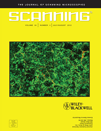Roughness Parameters for Standard Description of Surface Nanoarchitecture
Contract grant sponsor: Advanced Manufacturing Co-operative Research Centre (AMCRC).
Summary
The nanoarchitecture and surface roughness of metallic thin films prepared by magnetron sputtering were analyzed to determine the topographical statistics that give the optimum description of their nanoarchitechture. Nanoscale topographical profiles were generated by performing atomic force microscopy (AFM) scans of 1 μm × 1 μm areas of titanium and silver films of three different thicknesses (3 nm, 12 nm, and 150 nm). Of the titanium films, the 150-nm film had the highest average roughness (Ra = 2.63 nm), more than four times that of the 3-nm and 12-nm titanium films. When silver films were coated on top of 150-nm titanium films, the average roughness increased further; the 3-nm (Ra = 4.96 nm) and 150-nm (Ra = 4.65 nm) silver films average roughnesses were approximately twice that of the 150-nm titanium film. For topographical analysis, seven statistical parameters were calculated. These parameters included commonly used roughness measurements, as well as some less commonly used measurements, in order to determine which combination of parameters gave the best overall description of the nanoarchitecture of the films presented. Skewness (Rskw), surface area increase (Rsa), and peak counts (Rpc) provided the best description of horizontal surface dimensions, and in conjunction with vertical descriptors Ra and Rq gave the best characterization of surface architecture. The five roughness parameters Ra, Rq, Rskw, Rsa, and Rpc are proposed as a new standard for describing surface nanoarchitecture. SCANNING 34: 257-263, 2012. © 2012 Wiley Periodicals, Inc.




